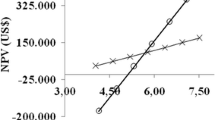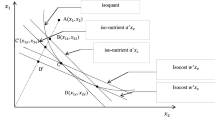Abstract
The study focused on investment, profitability, and input–output specific technical and scale efficiencies and suggested appropriately for its sustainable development in Andhra Pradesh. Farmers (n = 60) were interviewed, and data were analyzed using descriptive statistics, B-C ratio, C-D production function, and DEA techniques. The results depicted that majority of the farmers’ primary occupation was aquaculture and 53% of them were farming on leased land. Yield (kg/ha) was highest for large farmers (5247 kg) followed by medium (5200 kg) and small farmers (4800 kg) which resulted the net incomes of $8771 for large farmers, medium ($7377), and small farmers ($6186). The share of feed cost and medicine cost was higher for large farmers, while feed and other costs were highest for medium and small farmers. Net returns were found to be proportional to the land holdings, while labor days have a negative effect. Inefficiency scores given by the DEA model suggest farmers were able to produce the same level of output with combination of inputs corresponding to the minimum cost of production. Adoption of scientific farming practices and CAA guidelines may ensure sustainable farm income. The DoF, AP has to frame policies for the promotion and monitoring of inland low-saline shrimp culture for the mutual benefit of all stakeholders.



Similar content being viewed by others
Data availability
Data used in the present study are available from the first author on reasonable request.
References
Akber MA, Islam MA, Ahmed M, Rahman MM, Rahman MR (2017) Changes of shrimp farming in southwest coastal Bangladesh. Aquacult Int 25(5):1883–1899
Allan GL, Fielder DS, Fitzsimmons KM, Applebaum SL, Raizada S (2009) Inland saline aquaculture. In New technologies in aquaculture, pp. 1119–1147
Anon SFII (2002) Aquaculture authority news. Vol. 1. Chennai (India): Ministry of Agriculture, Government of India, Coastal Aquaculture Authority. pp. 1–16
Balakrishnan GS, Peyail RK, Theivasigamani A, Anil K, Jitesh S, Srinivasan N (2011) First report on white spot syndrome virus (WSSV) infection in white leg shrimp Litopenaeus vannamei (Crustacea, Penaeidae) under semi-intensive culture condition in India. AACL Bioflux 4(3):301–305
Bessent A, Bessent W, Charnes A, Cooper WW, Thorogood N (1983) Evaluation of educational program proposals by means of data envelopment analysis. Educ Adm Q 19(2):82–107
BFDA (1997) Brackish water shrimp farming development authority records, 1996–1997. Nellore (India): Brackishwater Shrimp Farming Development Authority. p. 772
Boussofiane A, Dyson RG, Thanassoulis E (1991) Applied data envelopment analysis. Eur J Oper Res 52(1):1–15
Bray WA, Lawrence AL, Leung-Trujillo JR (1994) The effect of salinity on growth and survival of Penaeus vannamei, with observations on the interaction of IHHN virus and salinity. Aquaculture 122(2–3):133–146
CAA (2008) Import of SPF broodstock of L. vannamei by shrimp hatcheries. F. No.56–3/2010-Tech. Coastal Aquaculture Authority, Chennai, India
CAA- Coastal Aquaculture Authority, 2005. Guidelines for regulating coastal aquaculture. Department of Fisheries, Ministry of Fisheries, Animal Husbandry and Dairying, Government of India. Available on URL: http://caa.gov.in/uploaded/doc/Guidelines-Englishnew.pdf. (Accessed on 05–01–2022)
Charnes A, Cooper WW, Rhodes E (1978) Measuring the efficiency of decision making units. Eur J Oper Res 2(6):429–444
Charnes A, Cooper W, Lewin AY, Seiford LM (1997) Data envelopment analysis theory, methodology and applications. J Oper Res Soc 48(3):332–333
Coelli T (1996) A guide to DEAP version 2.1: a data envelopment analysis (computer) program, (CEPA Work Pap 96/08), pp. 1–49
Cost of cultivation, Directorate of economics and statistics, department of agriculture and farmers welfare, ministry of agriculture and farmers welfare, Govt. of India. Available at URL: https://eands.dacnet.nic.in/Cost_of_Cultivation.htm. Accessed on 02–11–2022.
Department of Fisheries (DoF), West Godavari district, Andhra Pradesh. Available on URL: https://westgodavari.ap.gov.in/fisheries/. (Accessed on 20–11–2021).
Dhande DK (2022) Economic assessment of freshwater fish culture systems vis-à-vis paddy cultivation in Andhra Pradesh. Ph.D. Thesis. Central Institute of Fisheries Education (University under Sec. 3 of UGC Act, 1956), Versova, Mumbai, India -400061
Dorababu KK (2013) Impact of aquaculture on land use patterns, environment and economy: a case study of West Godavari District, Andhra Pradesh, India. Int J Curr Res 5(7):1993–1996
Durai V, Alagappan M, Venkatesan M (2020) Techno-economic analysis of Shrimp farming in Coastal districts of Tamilnadu. Young (up to 34 years) 23:15–33
Flaherty M, Szuster B, Miller P (2000) Low salinity inland shrimp farming in Thailand. AMBIO. J Human Environ 29(3):174–179
Ji YB, Lee C (2010) Data envelopment analysis. Stata J 10(2):267–280
Karunasagar I, Otta SK, Karunasagar I (1997) Histopathological and bacteriological study of white spot syndrome of Penaeus monodon along the west coast of India. Aquaculture 153(1–2):9–13. https://doi.org/10.1016/S0044-8486(97)00011-2
Kumar MPV, Singh N (2019) An economic analysis of paddy production in Raichur District, Karnataka, India. Int J Curr Microbiol App Sci 9:183–193
Marine Products Export Development Authority. State wise shrimp production and area under cultivation between 2009–10 to 2020–21. Available at URL: https://mpeda.gov.in/?page_id=651. Accessed on 21/27/2022.
Mugaonkar P, Kumar NR, Biradar RS (2019) Economics and determinants of Pangas catfish production in India. Fish Technol 56(1):80–88
Nagothu US, Muralidhar M, Kumaran M, Muniyandi B, Umesh NR, Krishna Prasad KS, De Silva S (2012) Climate change and shrimp farming in Andhra Pradesh, India: socio-economics and vulnerability. Energy Environ Res 2(2):137–148
Narkis C, Uma K, Rohini A, Vasanthi R (2021) An economic analysis of shrimp (Litopenaeus vannamei) in Nagapattinam District of Tamil Nadu. Asian J Agric Ext Econ Soc 39(10):450–454
Nguyen KT, Fisher TC (2014) Efficiency analysis and the effect of pollution on shrimp farms in the Mekong river delta. Aquac Econ Manag 18(4):325–343
Nisar U, Kumar NR, Yadav VK, Sivaramane N, Prakash S, Qureshi NW (2017) Economics and resource-use efficiency in exotic carp production in Jammu & Kashmir. Agric Econ Res Rev 30(2):305–311
Radhakrishnan K, Narayanakumar R, Krishnan M, Sivaraman I, Infantina JA (2021) Techno-economic efficiency of marine fisheries in Gulf of Mannar Biosphere Reserve. India. Indian J Geo Mar Sci 50(09):729–735
Reicher SD (1982) The determination of collective behaviour. In: Tajfel H (ed) Social identity and intergroup relations. Cambridge University Press, Cambridge, pp 41–83
Salunke M, Kalyankar A, Khedkar CD, Shingare M, Khedkar GD (2020) A review on shrimp aquaculture in India: historical perspective, constraints, status and future implications for impacts on aquatic ecosystem and biodiversity. Rev Fish Sci Aquac 28(3):283–302
Samarpitha A, Vasudev N, Suhasini K (2017) Economics of rice cultivation in west Godavari district of Andhra Pradesh and strategies to reduce cost of cultivation. Indian J Econ Dev 13(2a):314–318
Sen SR (1979) Committee report on cost of cultivation. Ministry of Agriculture, Government of India. pp. 21
Sivaraman I, Krishnan M, Ananthan PS, Satyasai KJS, Krishnan L, Haribabu P (2015) Technical efficiency of shrimp farming in Andhra Pradesh: estimation and implications. Curr World Environ 10(1):199–205
Society of Aquaculture Professionals (SAP), India. India’s farmed shrimp sector in 2020: a white paper. Available at URL: https://aquaasiapac.com/2021/07/31/indias-farmed-shrimp-sector-in-2020-a-white-paper/ accessed on 21–07–2022
Srinivasan JT (2012) An economic analysis of paddy cultivation in the Kole land of Kerala. Indian J Agric Econ 67(2):213–224
The Fish Site.com: Available on URL:https://thefishsite.com/articles/acclimating-pacific-white-shrimp-to-inland-lowsalinity-waters. Accessed on 02–01–2022
Vijayan KK, Balasubramanian CP, Kannappan S, Jayanthi M, Panigrahi A, Rekha PN, Aravind R (2018) Training manual on recent advances in farming of pacific white shrimp
Y.K Alagh committee report (2005) Report of the expert committee to examine methodological issues in fixing MSP. Ministry of Agriculture, Government of India, Krishi bhawan, New Delhi. pp. 40
Zhang H, Nisar U, Mu Y (2022) Evaluation of technical efficiency in exotic carp polyculture in Northern India: conventional DEA vs. bootstrapping methods. Fishes 7(4):1–15
Acknowledgements
The authors are grateful to the Director/Vice-Chancellor, ICAR-CIFE, Mumbai for providing all the necessary facilities for conducting this study during the Ph.D. program along with financial support.
Funding
The ICAR- Central Institute of Fisheries Education, Mumbai, India, has funded the research project of the first author through institutional fellowship during his doctoral degree. Dr. Rama Sharma was paid a monthly salary by the ICAR- Central Institute of Fisheries Education, Mumbai, India. Mr. Ravi Shankar Kumar has received a monthly salary from the College of Fisheries, Kishanganj, Bihar, India. Gora Shiva Prasad has been awarded institutional fellowship by West Bengal University of Animal and Fishery Sciences, Kolkata, India.
Author information
Authors and Affiliations
Contributions
First author - Data collection, analysis, compilation and draft preparation.
Second author - Actively engaged in preparing interview schedule, assisted in analysis and final draft preparation.
Third author - Preparing interview schedule, compilation and draft preparation.
Fourth author - Assisted in data collection, data entry and analysis.
Corresponding author
Ethics declarations
Ethical approval and consent to participate
Not applicable.
Human and animal ethics
The first author declares that neither human nor animal affected and research ethics were strictly followed.
Consent for publication
All authors are aware of the research work done and have given their consent to publish the work with Aquaculture international.
Competing interests
The authors declare no competing interests.
Additional information
Handling Editor: Gavin Burnell
Publisher's Note
Springer Nature remains neutral with regard to jurisdictional claims in published maps and institutional affiliations.
Rights and permissions
Springer Nature or its licensor (e.g. a society or other partner) holds exclusive rights to this article under a publishing agreement with the author(s) or other rightsholder(s); author self-archiving of the accepted manuscript version of this article is solely governed by the terms of such publishing agreement and applicable law.
About this article
Cite this article
Dhande, K.K., Sharma, R., Kumar, R.S. et al. Inland low saline shrimp culture in Andhra Pradesh: profitability and resource use efficiency. Aquacult Int (2024). https://doi.org/10.1007/s10499-024-01480-w
Received:
Accepted:
Published:
DOI: https://doi.org/10.1007/s10499-024-01480-w




